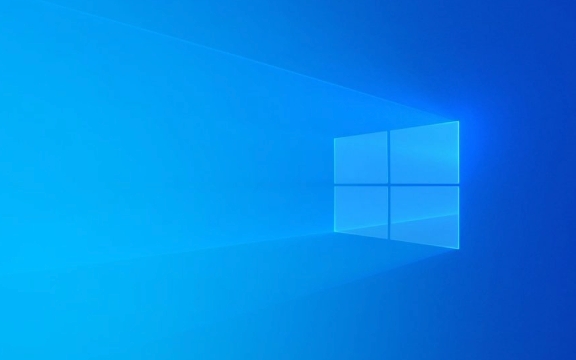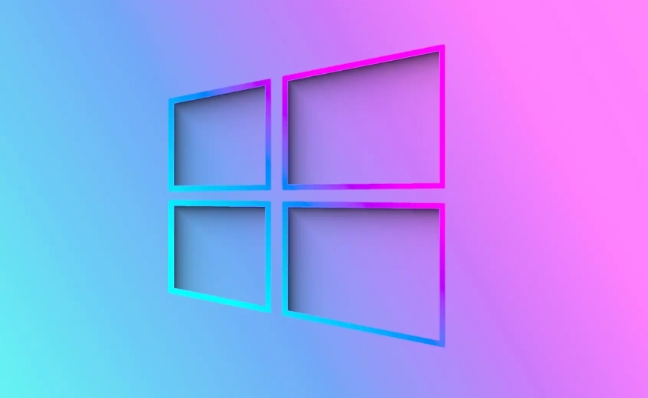How to set file and folder permissions in Windows
Jul 31, 2025 am 07:55 AMUnderstand permission types: Read, Write, Read & Execute, Modify, and Full Control determine user access levels. 2. To change permissions, right-click the file or folder, select Properties, go to Security tab, click Edit, Add the user or group, verify with Check Names, select appropriate Allow permissions, then click Apply and OK. 3. If access is denied, take ownership via Properties > Security > Advanced > Change owner, enter your username, verify, enable Replace owner on subcontainers if needed, then apply. 4. Use built-in groups like Users, Administrators, or Everyone for simpler management, but restrict Everyone carefully. 5. Follow best practices: limit Full Control, apply least privilege, review permissions regularly, back up data before changes, and test on non-critical files to avoid lockout or data exposure. Managing Windows permissions effectively relies on the Security tab and thoughtful access control to protect sensitive data.

Setting file and folder permissions in Windows helps control who can access, modify, or delete your data. This is especially important on shared computers or in business environments. Here’s how to manage permissions properly using the built-in tools.

1. Understanding Permission Types
Before making changes, it helps to know the basic permission levels in Windows:
- Read: View the file or folder.
- Write: Modify or add files.
- Read & Execute: Read and run programs.
- Modify: Read, write, and delete.
- Full Control: Complete access, including changing permissions.
These apply to users and groups like "Administrators," "Users," or specific account names.

2. How to Change Permissions on a File or Folder
Follow these steps to set or modify permissions:
- Right-click the file or folder and select Properties.
- Go to the Security tab.
- Click Edit… to change permissions.
- In the new window, click Add… to include a user or group.
- Type the username (e.g., "John") or click Advanced to search.
- Click Check Names to verify, then OK.
- Once the user is added, select their name and check the Allow boxes for the desired permissions (e.g., Read, Modify).
- Click Apply, then OK.
? If you're not the owner, you might not have permission to change settings. You may need to take ownership first (see below).

3. Taking Ownership of a File or Folder (When Needed)
If you can’t change permissions due to access denied errors:
- Open Properties > Security > Advanced.
- Next to Owner, click Change.
- Enter your username, click Check Names, then OK.
- Check Replace owner on subcontainers and objects if applying to a folder with contents.
- Click Apply. You should now be able to edit permissions.
4. Use Built-in Groups for Simplicity
Instead of adding individual users, consider using default groups:
- Users: All standard users.
- Administrators: Full control by default.
- Everyone: Applies to all accounts (use carefully).
For example, removing "Everyone" or "Users" from sensitive folders limits access to only those explicitly granted.
5. Tips and Best Practices
- Be cautious with "Full Control": Only give it to trusted users.
- Use the principle of least privilege: Give only the access needed.
- Regularly review permissions, especially on shared drives.
- Back up important data before changing permissions on critical files.
?? Misconfigured permissions can lock you out or expose private data. When in doubt, test changes on a non-critical file first.
Basically, managing permissions in Windows comes down to the Security tab and understanding who needs what level of access. It’s not complicated once you get the hang of it—just be careful with system files and shared resources.
The above is the detailed content of How to set file and folder permissions in Windows. For more information, please follow other related articles on the PHP Chinese website!

Hot AI Tools

Undress AI Tool
Undress images for free

Undresser.AI Undress
AI-powered app for creating realistic nude photos

AI Clothes Remover
Online AI tool for removing clothes from photos.

Clothoff.io
AI clothes remover

Video Face Swap
Swap faces in any video effortlessly with our completely free AI face swap tool!

Hot Article

Hot Tools

Notepad++7.3.1
Easy-to-use and free code editor

SublimeText3 Chinese version
Chinese version, very easy to use

Zend Studio 13.0.1
Powerful PHP integrated development environment

Dreamweaver CS6
Visual web development tools

SublimeText3 Mac version
God-level code editing software (SublimeText3)

Hot Topics
 How to Set Up a Dual Monitor Display on Windows
Jul 27, 2025 am 04:16 AM
How to Set Up a Dual Monitor Display on Windows
Jul 27, 2025 am 04:16 AM
TosetupdualmonitorsonWindows,firstcheckhardwarecompatibilitybyensuringyourGPUhasmultiplevideoportsandyouhavethecorrectcables;connectthesecondmonitor,poweronbothdisplays,andletWindowsdetectthemautomatically;thenopenDisplaysettings,identifyandarrangeth
 How to install Composer on Windows?
Jul 25, 2025 am 01:28 AM
How to install Composer on Windows?
Jul 25, 2025 am 01:28 AM
CheckPHPinstallationbyrunningphp-vinCommandPromptandensurePHPisinPATH.2.DownloadtheComposer-Setup.exeinstallerfromgetcomposer.org,runit,followthewizard,andallowsystem-wideinstallation.3.Verifyinstallationbyrunningcomposer--versioninanewCommandPromptt
 What is a blockchain fork? How to understand and deal with blockchain network forks?
Jul 24, 2025 pm 09:57 PM
What is a blockchain fork? How to understand and deal with blockchain network forks?
Jul 24, 2025 pm 09:57 PM
Blockchain forks are the natural result of network upgrades and community differences. 1. Soft forks are mild upgrades that are forward compatible, and old nodes can still verify new blocks; 2. Hard forks lead to permanent chain splits, and all nodes must be upgraded otherwise they will remain in the original chain; 3. The reasons for forks mainly include technological upgrades, community concept differences and unexpected network problems; 4. User response strategies are to pay attention to official information, understand asset mapping rules, beware of fraud risks, and suspend operations during forks to ensure asset security and correctly handle new and old chain assets. Ultimately, understanding forks will help to deeply grasp the decentralized evolutionary nature of web3.
 How to create a bootable USB drive for Windows?
Jul 26, 2025 am 07:57 AM
How to create a bootable USB drive for Windows?
Jul 26, 2025 am 07:57 AM
To create a bootable Windows USB drive, you need to select the right tools and mirror files and follow the steps. 1. Prepare 8GB or more USB drives, networked computers, official ISO files and production tools such as MediaCreationTool or Rufus; 2. Use MediaCreationTool to quickly create the latest system installation disk. It takes about 10 to 20 minutes to write to the USB drive after selecting the corresponding language and version; 3. Rufus provides more customization options, supports loading any ISO files and selecting partition plans; 4. After the production is completed, you need to enter the BIOS/UEFI setting to turn off SecureBoot, adjust the startup sequence, and confirm the startup using the USB drive; the parameters need to be carefully selected throughout the process to ensure installation
 How to fix 'There are currently no power options available'
Jul 27, 2025 am 01:22 AM
How to fix 'There are currently no power options available'
Jul 27, 2025 am 01:22 AM
First run the power troubleshooter, then use the administrator command prompt to execute the powercfg-restoredefaultschemes command to reset the power scheme, then update or reinstall the ACPI driver, check the Group Policy settings (Pro/Enterprise Edition only), run sfc/scannow to repair the system files, and determine whether it is a user profile problem by creating a new user account. In most cases, the power options will return to normal.
 Windows night light not working
Jul 29, 2025 am 05:34 AM
Windows night light not working
Jul 29, 2025 am 05:34 AM
Night mode cannot adjust the color temperature or does not take effect, which is usually caused by system settings or driving problems. First check whether night mode is actually enabled: go to Settings > System > Display, confirm that the "Night Mode" switch is on. If the gray is not selected, it may be a problem with the graphics card driver or system version; secondly, if the color temperature adjustment is invalid, you can try restarting the Explorer, use the registry to repair, reset the night mode settings, and turn off the conflicting third-party software; finally check the time and geographic location permissions: Ensure that the location is allowed in the privacy settings, and enable the automatic time and time zone setting function.
 How to install Windows on a RAID array
Jul 25, 2025 am 01:46 AM
How to install Windows on a RAID array
Jul 25, 2025 am 01:46 AM
The key to installing Windows to RAID arrays is to correctly prepare the driver and set up BIOS/RAID. 1. Download and prepare the corresponding model of RAID controller driver in advance to ensure that it matches the Windows version and system bit count; 2. Set SATA mode to RAID in BIOS and create an array through the RAID tool to ensure that the status is normal; 3. Import the RAID driver through the "Load Drive" function during the installation process, so that the installer can identify the array; 4. After installation, the motherboard chipset driver needs to be installed, check the array status regularly, and use manufacturer tools to monitor performance to avoid replacing the hard disk at will. Do these steps and the RAID installation will be completed smoothly.
 How to install VSCode on Windows
Jul 27, 2025 am 03:16 AM
How to install VSCode on Windows
Jul 27, 2025 am 03:16 AM
Gotohttps://code.visualstudio.comanddownloadtheWindowsUserInstaller.2.Runthe.exefile,allowchanges,andselectrecommendedoptionsincludingaddingtoPATHandcreatingadesktopshortcut.3.ClickFinishtolaunchVSCodeafterinstallation.4.Optionallyinstallusefulextens







